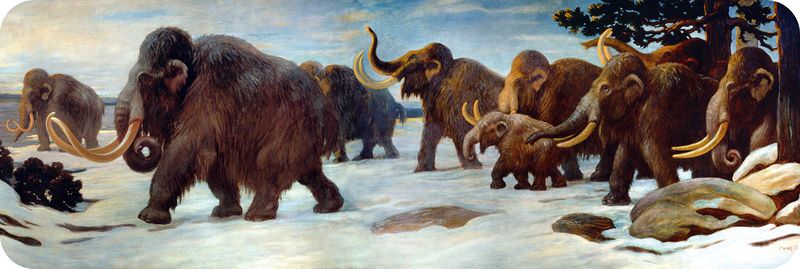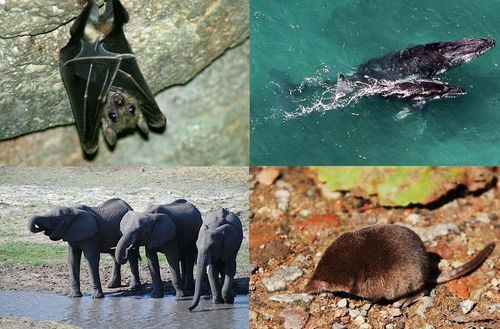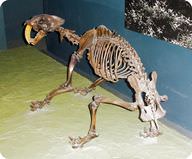19.6新生代生命史
章节大纲
-
Do these animals look familiar?
::这些动物看起来眼熟吗?The ice ages were very recent as Earth history goes. The animals are familiar, but they're still very different from modern ones. For one thing, most of them were huge. A small surface area-to-volume ratio is better for keeping warm (less surface to lose heat from). Although the dominant animals were mammals, the Pleistocene Earth still does not look quite modern.
::随着地球历史的流逝,冰河时代是最近才开始的。动物是熟悉的,但它们与现代动物仍然有很大不同。有一件事是,它们中的大部分是巨大的。小的地表面积和体积比比较适合保持温暖(没有表层可以失去热量 ) 。 尽管占优势的动物是哺乳动物,但Pleistocene地球看起来仍然不太现代。The Cenozoic Era
::Cenozoic 时代The Cenozoic Era is going on right now! It is sometimes called “the age of mammals”. The Cenozoic began 66 million years ago with the extinction of the non-avian dinosaurs and other large land creatures. Organisms that survived the mass extinction then evolved to fill the niches the dinosaurs had left open.
::代之地时代正在继续!它有时被称为“哺乳动物时代 ” , 6600万年前随着非禽类恐龙和其他大型陆地生物的灭绝而开始。 幸免于大规模灭绝的有机体随后演变为填补恐龙留下的空隙。There was a huge radiation of mammals and birds. Both groups became common and diverse in the Cenozoic. Both mammals and birds have the ability to regulate their own body . They are endotherms (warm blooded). This helped them survive as Earth’s climate followed a general cooling trend.
::哺乳动物和鸟类受到巨大辐射。 这两种动物在基因组中都变得常见和多样化。 哺乳动物和鸟类都有能力调节自己的身体。它们是热热热(热血 ) , 这有助于它们生存,因为地球气候随总体冷却趋势而变化。Left: A pelican, catching a fish. Center: A hummingbird, taking a sip from a flower. Right: A falcon, ready to catch its prey. Diversification of the Mammals
::哺乳动物多样化Mammals have adapted to all sorts of different environments. They were able to spread to even more environments than the reptiles. Mammals are endothermic and have fur, hair, or blubber for warmth. Mammals can walk, swim, or fly. They can live in nearly all terrestrial environments. Mammals initially filled the forests that covered many early Cenozoic lands. When grasslands arose, mammals evolved to fill those niches too. You can see pictures of many different mammals below ( Figure ).
::哺乳动物适应了各种不同的环境,它们能够传播到比爬行动物更多的环境。哺乳动物是异性通热动物,有毛皮、毛发或脂肪,可以取暖。哺乳动物可以行走、游泳或飞翔。它们可以生活在几乎所有的陆地环境中。哺乳动物最初填满了覆盖许多早期的基因突变土地的森林。当草原出现时,哺乳动物也会进化,以填补这些位置。你可以看到下面许多不同的哺乳动物的照片(图示 ) 。(top left) This bat lives in a cave, emerging at night to find food. (top right) Although you might not guess it, these humpback whales are gigantic, ocean-dwelling mammals. (bottom right) This Eurasian pygmy shrew has found a home on the forest floor. It is only a few inches long. (bottom left) These African elephants are native to central Africa. Pleistocene Megafauna
::巨型动物As climate cooled during the ice ages, large mammals evolved. These are called the Pleistocene megafauna. Mastodons, giant sloths, wooly mammoths, giant condors, and saber tooth cats all evolved ( Figure ).
::随着冰河时期气候的冷却,大型哺乳动物的进化。这些动物被称为Pleistocene巨型动物。马斯托登斯、巨、羊毛长毛象、巨神鹰和剑齿猫都是进化的(图 ) 。The saber-toothed cat lived during the Pleistocene. "The Evolution of Life in 60 Seconds" video scales all 4.6 billion years of Earth history into one minute. Don’t blink at the end!
::“60秒生命的进化”视频将地球历史上46亿年的视频缩放成一分钟。Many of the organisms that made up the Pleistocene megafauna went extinct as conditions warmed. Some may have been driven to extinction by human activities.
::形成Pleistocene巨型动物的许多生物随着气候变暖而灭绝,有些可能因人类活动而灭绝。Other Cenozoic animals include hooved mammals, whales, primates , and eventually humans.
::其他的蛋白质动物包括休眠哺乳动物、鲸鱼、灵长类动物,最终还有人类。Imagine a vast grassy plain covered with herds of elephants, bison, and camels stretching as far as the eye can see. Lions, tigers, wolves, and, later, humans, hunt the herds on their summer migration. This was the San Francisco Bay Area at the close of the last ice age.
::想象一下,在一片广大的草原上,大象、野牛和骆驼的群落遍及最远的目光。 狮子、老虎、狼和后来的人类在夏季迁徙时猎杀牛群。 这是上一个冰河时代的近距离,旧金山湾地区。Summary
::摘要- With the extinction of the dinosaurs, niches were open for birds and mammals to fill.
::随着恐龙的灭绝 空地被打开 鸟和哺乳动物可以填满
- Birds and mammals are endotherms. Both are diverse and abundant.
::鸟类和哺乳动物是热源,两者丰富多样。
- Many of the organisms of the Pleistocene ice ages were enormous. Animals with a low surface area to body ratio are better able to keep warm.
::地表面积与身体比率低的动物更能保持温暖。
- Many of the Pleistocene megafauna have gone extinct.
::许多Pleistocene巨型动物已经灭绝。
Review
::回顾- What are the Pleistocene megafauna, and why were they so large?
::何为巨型巨型动物 为何巨型巨型巨型巨型巨型巨型巨型巨型巨型巨型巨型巨型巨型巨型巨型巨型巨型巨型巨型巨型巨型巨型巨型巨型巨型巨型巨型巨型巨型巨型巨型巨型巨型巨型巨型巨型巨型巨型巨型巨型巨型巨型巨型巨型巨型巨型巨型巨型巨型巨型巨型巨型巨型巨型巨型巨型巨型巨型巨型巨型巨型巨型巨型巨型巨型巨型巨型巨型巨型巨型巨型巨型巨型巨型巨型巨型巨型巨型巨型巨型巨型巨型巨型巨型巨型巨型巨型巨型巨型巨型巨型巨型巨型巨型巨型巨型巨型巨型巨型巨型巨型巨型巨型巨型巨型巨型巨型巨型巨型巨型巨型巨型巨型巨型巨型巨型巨型巨型巨型巨型巨型巨型巨型巨型巨型巨型巨型巨型巨型巨型巨型巨型巨型巨型巨型巨型巨型巨型巨型巨型巨型巨型巨型巨型巨型巨型巨型巨型巨型巨型巨型巨型巨型巨型巨型巨型巨型巨型巨型巨型巨型巨型巨型巨型巨型巨型巨型巨型巨型巨型巨型巨型巨型巨型巨型巨型巨型巨型巨型巨型巨型巨型巨型巨型巨型巨型巨型巨型巨型巨型巨型巨型巨型巨型巨型巨型巨型巨型巨型巨型巨型巨型巨型巨型巨型巨型巨型巨型巨型巨型巨型巨型巨型巨型巨型巨型巨型巨型巨型巨型巨型巨型巨型巨型巨型巨型巨型巨型巨型巨型巨型巨型巨型巨型巨型巨型巨型巨型巨型巨型巨型巨型巨型巨型巨型巨型巨型巨型巨型巨型
- What characteristics do mammals have that allow them to fill so many niches and what do each of those things do?
::哺乳动物有哪些特征允许它们填充如此多的位子? 每一种哺乳动物都做些什么?
- List some of the types of mammals and state how they live.
::列出一些哺乳动物的类型,并说明它们是如何生活的。
- With the extinction of the dinosaurs, niches were open for birds and mammals to fill.



